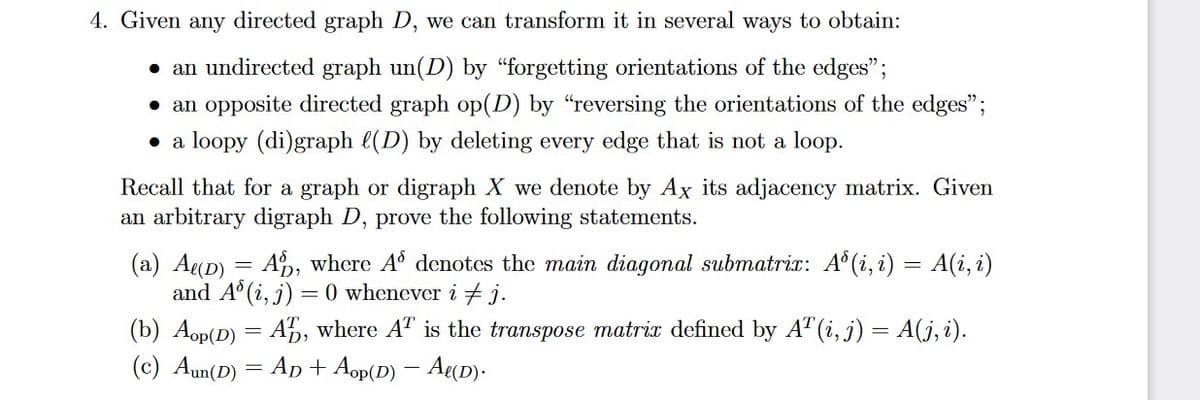4. Given any directed graph D, we can transform it in several ways to obtain: • an undirected graph un(D) by "forgetting orientations of the edges"; • an opposite directed graph op(D) by "reversing the orientations of the edges"; • a loopy (di)graph ((D) by deleting every edge that is not a loop. Recall that for a graph or digraph X we denote by Ax its adjacency matrix. Given an arbitrary digraph D, prove the following statements. (a) A(D) = A, where A° denotes the main diagonal submatrir: A°(i, i) = A(i, i) and A° (i, j) = 0 whenever i + j. (b) Aop(D) = A5, where A" is the transpose matri defined by A" (i, j) = A(j, i). (c) Aun(D) = Ap + Aop(D) – A(D). %3D
4. Given any directed graph D, we can transform it in several ways to obtain: • an undirected graph un(D) by "forgetting orientations of the edges"; • an opposite directed graph op(D) by "reversing the orientations of the edges"; • a loopy (di)graph ((D) by deleting every edge that is not a loop. Recall that for a graph or digraph X we denote by Ax its adjacency matrix. Given an arbitrary digraph D, prove the following statements. (a) A(D) = A, where A° denotes the main diagonal submatrir: A°(i, i) = A(i, i) and A° (i, j) = 0 whenever i + j. (b) Aop(D) = A5, where A" is the transpose matri defined by A" (i, j) = A(j, i). (c) Aun(D) = Ap + Aop(D) – A(D). %3D
Advanced Engineering Mathematics
10th Edition
ISBN:9780470458365
Author:Erwin Kreyszig
Publisher:Erwin Kreyszig
Chapter2: Second-order Linear Odes
Section: Chapter Questions
Problem 1RQ
Related questions
Question
attached below

Transcribed Image Text:4. Given any directed graph D, we can transform it in several ways to obtain:
• an undirected graph un(D) by "forgetting orientations of the edges";
• an opposite directed graph op(D) by "reversing the orientations of the edges";
• a loopy (di)graph l(D) by deleting every edge that is not a loop.
Recall that for a graph or digraph X we denote by Ax its adjacency matrix. Given
an arbitrary digraph D, prove the following statements.
(a) Ag(D) = A, where A° denotes the main diagonal submatrix: A° (i, i) = A(i, i)
and A° (i, j) = 0 whenever i + j.
(b) Aop(D) = A5, where AT is the transpose matri defined by A" (i, j) = A(j, i).
(c) Aun(D) = Ap + Aop(D) – A«D).
Expert Solution
This question has been solved!
Explore an expertly crafted, step-by-step solution for a thorough understanding of key concepts.
This is a popular solution!
Trending now
This is a popular solution!
Step by step
Solved in 5 steps

Recommended textbooks for you

Advanced Engineering Mathematics
Advanced Math
ISBN:
9780470458365
Author:
Erwin Kreyszig
Publisher:
Wiley, John & Sons, Incorporated

Numerical Methods for Engineers
Advanced Math
ISBN:
9780073397924
Author:
Steven C. Chapra Dr., Raymond P. Canale
Publisher:
McGraw-Hill Education

Introductory Mathematics for Engineering Applicat…
Advanced Math
ISBN:
9781118141809
Author:
Nathan Klingbeil
Publisher:
WILEY

Advanced Engineering Mathematics
Advanced Math
ISBN:
9780470458365
Author:
Erwin Kreyszig
Publisher:
Wiley, John & Sons, Incorporated

Numerical Methods for Engineers
Advanced Math
ISBN:
9780073397924
Author:
Steven C. Chapra Dr., Raymond P. Canale
Publisher:
McGraw-Hill Education

Introductory Mathematics for Engineering Applicat…
Advanced Math
ISBN:
9781118141809
Author:
Nathan Klingbeil
Publisher:
WILEY

Mathematics For Machine Technology
Advanced Math
ISBN:
9781337798310
Author:
Peterson, John.
Publisher:
Cengage Learning,

